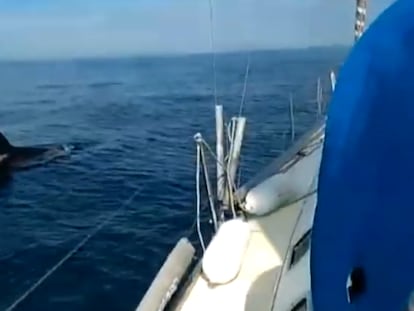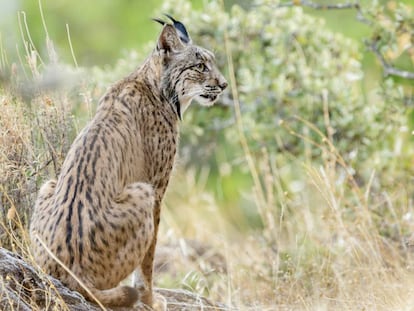Bison in Spain: the risks of introducing an ‘exotic’ species
A hundred specimens are living on large estates in the Spanish countryside. The last 18 arrived from Poland and settled in the Sierra de Andújar in Jaén. Some scientists warn of the danger of shoehorning this “exotic species” into the Mediterranean ecosystem while advocates argue for the animal’s conservation

From a distance, the baby bison could pass for just another calf from an ordinary cow, but what Alberto Herranz is carrying is something altogether different. It was born just a few days ago from one of the bison he keeps on La Perla, his rural estate in Cubillo, in the Spanish province of Segovia. The calf has suffered a tremendous attack of ticks and now Herranz is rubbing olive oil on it to dislodge the insects from the animal’s underbelly. Herranz has a dozen specimens of European bison (Bison bonasus), the only member of the megafauna together with the American bison that survived the great Pleistocene extinction, and whose introduction into Spain has raised concerns among a number of prominent scientists.
A rancher and businessman, Herranz belongs to a movement that aims to help build this species back up in Spain after it practically disappeared from the planet at the beginning of the 20th century. To this end, he brought the first two adult bison from Poland in 2017. Following years of recovery plans in other countries, the European bison is now listed by the IUCN (International Union for Conservation of Nature) as “Near Threatened” as opposed to “Vulnerable.” In 2019, 2,518 adult specimens lived in the wild in 10 northern European countries, predominantly Poland, Russia and Belarus.
In Spain, which is not on that list of 10 countries, there are around 100 European bison living in a dozen fenced estates like Herranz’s in the regions of Valencia, Castilla y León and Andalusia, according to the veterinarian Fernando Morán, who heads an association called European Bison Conservation Center in Spain. Morán is involved in practically all the transfers of these animals, which come mostly from Poland with the first specimens arriving in 2010. The last transfer at the end of 2020 involved 18 specimens that were released in El Encinarejo, a hunting estate in the province of Jaén, close to the Sierra de Andújar Natural Park.
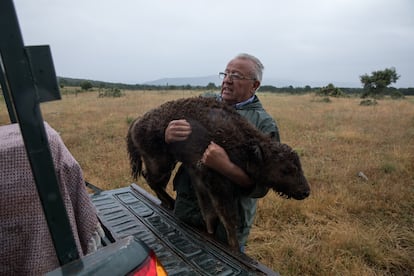
The Jaén project is the most important initiative currently underway, explains Morán. But it is also the one that has triggered the most scientific opposition. Twelve renowned experts have objected to the transfer, which they define as an “introduction of an exotic species into a Mediterranean ecosystem which has no documented historical records of its presence.” This is stated in one of the two letters sent to the Andalusian regional government to which EL PAÍS has had access. Among the signatories are Miguel Delibes de Castro, former director of the Doñana Biological Station; Concepción Azorit Casas, professor of zoology at the University of Jaén; Miguel Ángel Simón, former director of the successful Iberian lynx recovery project; and Carlos Fernández Delgado, a doctor of biology and professor at the University of Córdoba.
This group of 12 experts maintains that EU legislation obliges Spain to protect its “habitats and species linked to Mediterranean ecosystems” and warns that the species poses “a potential risk to these due to its high nutritional requirements as a large herbivore.” The scientists have asked that a project they term “inadequate” be halted so that “its possible repercussions can be analyzed by the mandatory scientific and social participation bodies.” However, the Andalusian authorities have failed to heed their requests.
Meanwhile, Morán says the furthest the project has got so far is in Andújar, where the regional government of Andalusia has recognized that the introduction of the animals into a fenced area is part of a program for the recovery of an endangered species. However, the official license to keep them there designates the space as a “zoological nucleus,” a term used for shelters, breeding centers, pet shops and any other spaces that keep animals. And the bison arrived in Spain as regular livestock and as such have to undergo the appropriate veterinary check-ups.
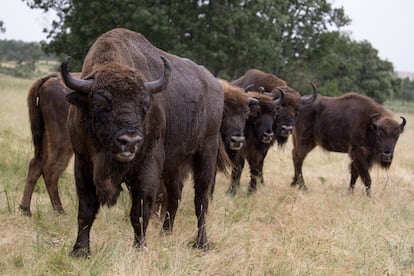
Morán says he intends to ask the regional government of Andalusia later this year to change the project’s classification so that it is officially recognized as a “benign introduction.” That term refers to the establishment of a viable population of an endangered species in an area that does not correspond to its natural habitat. The petition for the change will be accompanied by a report from Morán’s team on the impact of the project during its first 12 months on the local flora and fauna, which must be neutral or positive in order for his plan to go forward.
However, Azorit does not believe it is possible to observe the entire negative impact of the experiment in the space of a year. “The bison is still an exotic species that is being shoe-horned in here,” she insists. Simón, for his part, points out that the 1,000-hectare estate in the Sierra de Andújar where a number of the bison now roam is also home to the Iberian lynx and warns of the potential impact of “the bison trampling on the rabbit burrows,” which are the main source of food for the endangered feline. “There are already studies documenting the impact of deer, which weigh much less than bison,” he adds. But, over and above these considerations, all the experts who oppose the introduction of this animal in Spain consulted by EL PAÍS use the same argument: the European bison was never native to the Iberian peninsula.
A 1,000-year-old debate
In the last 10 years, the release of specimens or the birth of calves within the approximately 10 active projects have been accompanied by media headlines heralding the bison’s “return” to Segovia, Extremadura, León and Andalusia after 10,000 years. The animals depicted in the Altamira prehistoric cave paintings in Cantabria were held up as evidence. But science has made it clear that those animals depicted in Altamira and other caves in the country could not be European bison, but rather a different species, the steppe bison (Bison priscus), which disappeared from the peninsula 12,000 years ago, becoming extinct across the globe 6,000 years later. This fact is recognized by the IUCN, which states that “paleontological and archaeological findings” indicate that the European species was never present in the Iberian Peninsula.

The zoologist and expert on the history of Iberian wildlife, Carlos Nores, also considers it “nonsense” to introduce European bison to Spain, turning them into the wild in a place they were unable to colonize naturally. “In the 90 centuries that have elapsed since the first specimens appeared and began to spread throughout Europe, they never reached the Mediterranean peninsulas,” says Nores, who is consulting more than 20 experts across the country from his base at the University of Oviedo for an article that argues against the release of this species in Spain.
On the other side of the fence is Benigno Varillas, a well-known environmental journalist and writer, who links the introduction of the European bison to the recovery of depopulated areas of rural Spain. “Instead of resurrecting cattle operations that no young person wants to return to, this great herbivore could help attract tourism as well as create jobs,” he says. It is the same argument put forward in his latest book, Recovering the wild: Iberian bison. Varillas states that the introduction of this animal could help to prevent wildfires in swathes of countryside that are filled with scrub.
The naturalist is in favor of releasing specimens into mountainous areas as well as into enclosed spaces, as part of a recovery program. He argues that Spain would have the capacity to accommodate some 3,000 animals and that jobs would be generated. But in order to reach this point, an important reform would have to be implemented; namely that the Bison bonasus be included in the list of extinct species in Spain’s natural environment, which would allow the introduction of specimens from other parts of the world into the wild.
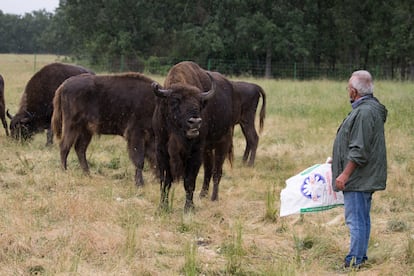
In 2017 and 2020, the advocates of these recovery projects twice tried to get the central government to include the European bison on the list of wild species under special protection in Spain to pave the way for its release into the wild. Morán says that his latest petition for the European bison to be included has the support of a hundred scientists and experts. Many of the signatories are members of the European project for the recovery of this species and of the IUCN committee specialized in bison, but there are also other prominent Spanish scientists, such as Juan José Negro, another former director of the Doñana Biological Station, who supports the classification of this species as wild in Spain. “They are being treated as livestock, when they are wild animals that get stressed when they are subjected to the mandatory sanitation checks,” he explains.
However, petitions to change the status of the European bison have met with objections from the scientific committee that advises the central government on drawing up the list of endangered species. José Luis Yela García, professor of zoology and biological conservation at the University of Castilla-La Mancha, is one of this advisory body’s 19 members. He points out that so far no remains have been found in the Iberian peninsula that correspond to the European bison, unlike the case of the steppe bison. But even if remains from 12,000 years ago were found, as in the case of the steppe bison, “the landscape of the peninsula has changed radically due to the climate and human activity,” he says. In other words, it is a completely different habitat.
The areas of Europe where the species survived until its virtual disappearance in the 19th and early 20th centuries were the forests of Poland and Belarus. “I don’t think the conditions are right in León or Jaén for this species,” adds Yela, while Simón, the former director of the lynx program, goes further: “In Jaén, it is already 40º C this week and it hasn’t rained for a month; they are going to get scorched,” he says. Meanwhile, Azorit puts it like this: “We see animals from the south coming up to the peninsula due to global warming and now we are going to bring bison in from Poland?” Zoologist Nores believes that the problem is an “ethical” one. “This animal is not adapted to the climate in the peninsula,” he says.

Herranz believes that his animals have adapted well to the conditions on his property, which is located in the foothills of the Guadarrama mountain range, though he does admit they are happiest in winter. “You should see how they roll around in the snow!” he says.
As a self-confessed animal lover, Herranz was keen to join the conservation project for the bison, the largest land mammal in Europe. He owns a stud farm and a breeding farm for fighting bulls and offers tours to see the bison and the other animals. Except for the help he has received from the Polish government to transport the animals, he says he has had no public funding to maintain the animals.
Morán, meanwhile, points out that the lack of public funding means that when his association studies a project presented to them by a private individual, they assess whether the species will bring an economic return. In the case of the bison, the return would come from ecotourism as many of the estates have guided tours. Morán is also in favor of a future hunting activity related to the bison, but only if it is a conservation hunt with the meat being put to use.
English version by Heather Galloway.
More information
